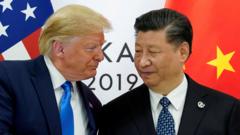In an effort to avert criticism from Donald Trump at the upcoming NATO summit, Secretary General Mark Rutte has proposed raising member nations' defense spending to 5% of GDP, more than doubling the current benchmark. While the plan aims to balance deterrence against Russia, many nations remain skeptical of meeting such a demanding target.
NATO's Bold Defense Spending Proposal: Aiming for Trump's Vision

NATO's Bold Defense Spending Proposal: Aiming for Trump's Vision
NATO Secretary General Mark Rutte pushes for a significant increase in defense spending across member nations to appease the U.S. and strengthen collective security.
At a pivotal NATO press briefing in Brussels, Secretary General Mark Rutte outlined an ambitious plan aiming to significantly boost defense spending among NATO allies – a move likely to appease former U.S. President Donald Trump. Rutte's proposal arises in a context reminiscent of the 2016 summit, where Trump heavily criticized European nations for perceived underinvestment in their military obligations.
Rutte's proposition calls for member states to allocate 5% of their gross domestic product (GDP) to defense, a drastic increase from the existing 2% target. This ambitious proposal seeks to not only fortify defenses against potential threats such as Russia but also cater to Trump's transactional view of geopolitical relationships, a concept that has characterized many aspects of his foreign policy.
To ease implementation, Rutte suggested a dual-tier spending framework: countries would commit to a core defense budget of 3.5%, with an additional 1.5% designated for "defense-related expenditures." This vague classification would permit nations to include various military-associated costs within their budgets, potentially leading to greater flexibility in how these allocations are planned and executed.
While this proposed increase assembles considerable support from figures like U.S. Defense Secretary Pete Hegseth, who claims multiple countries have expressed willingness to adopt the 5% target, doubts linger regarding actual commitment over time. With no clear timetable for achieving these goals and little enforcement power to sanction noncompliant states, the feasibility remains questionable.
Rutte will soon travel to the UK to engage with Prime Minister Sir Keir Starmer, whose defense initiatives currently aim for 2.5% GDP by 2027, with aspirations to further enhance spending thereafter. As discussions unfold, the broader implications of these proposals continue to captivate the attention of analysts, politicians, and defense strategists worldwide. The outcome at the forthcoming NATO summit will undoubtedly shape the alliance’s future trajectory and relations with the United States.



















